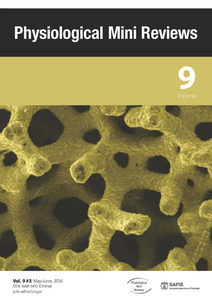Por favor, use este identificador para citar o enlazar este ítem:
https://repositorio.uca.edu.ar/handle/123456789/1447| Campo DC | Valor | Lengua/Idioma |
|---|---|---|
| dc.contributor.author | Garay, Arturo | es |
| dc.contributor.author | Cardinali, Daniel Pedro | es |
| dc.date.accessioned | 2019-05-02T13:56:15Z | - |
| dc.date.available | 2019-05-02T13:56:15Z | - |
| dc.date.issued | 2016 | - |
| dc.identifier.citation | Garay A., Cardinali, D. P. New concepts in the neurophysiology of sleep and wakefulness [en línea]. Physiological Mini Reviews. 2016, 9 (3). Disponible en: https://repositorio.uca.edu.ar/handle/123456789/1447 | es |
| dc.identifier.issn | 1669-5410 (online) | - |
| dc.identifier.uri | https://repositorio.uca.edu.ar/handle/123456789/1447 | - |
| dc.description.abstract | Abstract: The neural substrates of sleep and wakefulness form a highly distributed and, to some extent, redundant network, with hypocretin, monoaminergic and cholinergic systems largely promoting wakefulness and GABAergic systems in the preoptic area, hypothalamus and brainstem promoting sleep. The hypocretin/orexin system plays a special role in the promotion of wakefulness and suppression of REM sleep by providing excitatory input to the monoaminergic and cholinergic systems. Sleep is not a unitary state but involves a cyclic alternation between NREM and REM sleep; the pons is critical for generating the multiple components (ie, EEG synchronization, eye movements and muscle atonia) that characterize REM sleep. Recent findings have implicated the participation of hypothalamus, through MCH/GABA that provide a critical input to pontine generator of REM sleep. The timing of sleep and wakefulness is regulated by an interaction between the circadian pacemaker located in the hypothalamic SCN and a sleep homeostatic system whose anatomic location is yet to be definitively identified. Among various neurochemicals, extracellular AD and nNOS/NK1 accumulate in the BF as wakefulness is extended and inhibits cortically projecting cholinergic neurons, thereby influencing cortical activity. In the future, it seems reasonable to expect a spreading of these insights from basic to clinical grounds for a better understanding of the causes and mechanisms of sleep disorders and the generation of novel therapeutics in sleep medicine. | es |
| dc.format | application/pdf | es |
| dc.language | eng | es |
| dc.language.iso | eng | es |
| dc.publisher | Sociedad Argentina de Fisiología | es |
| dc.rights | Acceso Abierto | es |
| dc.rights.uri | https://creativecommons.org/licenses/by-nc-sa/4.0/ | es |
| dc.source | Physiological Mini Reviews, Vol. 9, N° 3, 2016 | es |
| dc.source | ISSN 1669-5410 (Online) | es |
| dc.subject | MEDICINA | es |
| dc.subject | SUEÑO | es |
| dc.subject | FISIOLOGIA | es |
| dc.subject | RITMO CIRCADIANO | es |
| dc.title | New concepts in the neurophysiology of sleep and wakefulness | es |
| dc.type | Artículo | es |
| uca.path | Facultad de Ciencias Médicas|Instituto de Investigaciones Biomédicas (BIOMED UCA-CONICET) | es |
| uca.disciplina | MEDICINA | es |
| uca.filename | /home/data-uca-generic/folder_generic/IIBiomedicas/new-concepts-neurophysiology-sleep/metadata.xml | es |
| uca.issnrd | 1 | es |
| uca.affiliation | Fil: Garay, Arturo. Hospital Universitario. Sección Medicina del Sueño. Unidad de Neurociencia; Argentina | es |
| uca.affiliation | Fil: Cardinali, Daniel Pedro. Pontificia Universidad Católica Argentina. Facultad de Ciencias Médicas. Departamento de Docencia e Investigación; Argentina | es |
| uca.version | publishedVersion | es |
| item.fulltext | With Fulltext | - |
| item.grantfulltext | open | - |
| item.languageiso639-1 | en | - |
| crisitem.author.dept | Consejo Nacional de Investigaciones Científicas y Técnicas | - |
| crisitem.author.dept | Instituto de Investigaciones Biomédicas - BIOMED | - |
| crisitem.author.dept | Facultad de Ciencias Médicas | - |
| crisitem.author.orcid | 0000-0002-0813-9088 | - |
| crisitem.author.parentorg | Facultad de Ciencias Médicas | - |
| crisitem.author.parentorg | Pontificia Universidad Católica Argentina | - |
| Aparece en las colecciones: | Artículos | |
Ficheros en este ítem:
| Fichero | Descripción | Tamaño | Formato | |
|---|---|---|---|---|
| new-concepts-neurophysiology-sleep.pdf | 1,16 MB | Adobe PDF |  Visualizar/Abrir |
Visualizaciones de página(s)
129
comprobado en 30-abr-2024
Descarga(s)
65
comprobado en 30-abr-2024
Google ScholarTM
Ver en Google Scholar
Este ítem está sujeto a una Licencia Creative Commons

